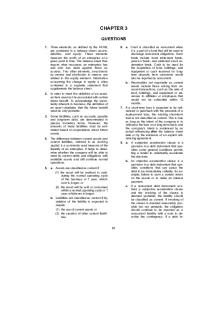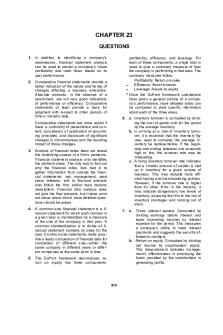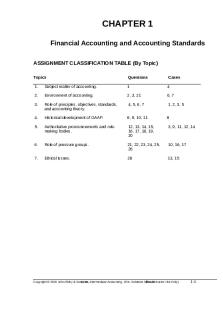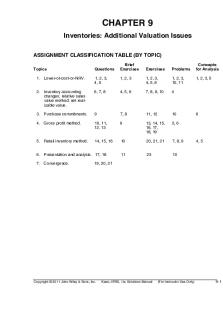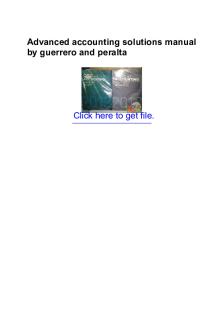Solutions Manual Intermediate Accounting 18e by Stice and Stice Ch03 PDF

| Title | Solutions Manual Intermediate Accounting 18e by Stice and Stice Ch03 |
|---|---|
| Course | Accounting |
| Institution | Đại học Hà Nội |
| Pages | 44 |
| File Size | 786.5 KB |
| File Type | |
| Total Downloads | 1 |
| Total Views | 58 |
Summary
To download more slides, ebook, solutions and test bank, visit CHAPTER 3 QUESTIONS 6. a. Cash is classified as noncurrent when it is a part of a fund that will be used to discharge noncurrent obligations. Such funds include bond retirement funds, pension funds, and preferred stock redemption funds. ...
Description
CHAPTER 3 QUESTIONS 1. Three elements, as defined by the FASB, are contained in a balance sheet: assets, liabilities, and equity. These elements measure the worth of an enterprise at a given point in time. The balance sheet thus reports what resources an enterprise has and who has claim against those resources. Two other elements, investments by owners and distribution to owners, are related to the equity element. Information concerning the change in equity is often contained in a separate statement that supplements the balance sheet.
6. a. Cash is classified as noncurrent when it is a part of a fund that will be used to discharge noncurrent obligations. Such funds include bond retirement funds, pension funds, and preferred stock redemption funds. Cash to be used for the acquisition of land, buildings, and equipment or cash received on longterm deposits from customers would also be reported as noncurrent. b. Receivables not reportable as current assets include those arising from unusual transactions, such as the sale of land, buildings, and equipment or advances to affiliates or employees that would not be collectible within 12 months. 7. If a short-term loan is expected to be refinanced or paid back with the proceeds of a replacement loan, the existing short-term loan is not classified as current. This is true as long as the intent of the company is to refinance the loan on a long-term basis and the company’s intent is evidenced by an actual refinancing after the balance sheet date or by the existence of an explicit refinancing agreement. 8. a. A subjective acceleration clause is a provision in a debt instrument that specifies some general conditions permitting a lender to unilaterally accelerate the due date. b. An objective acceleration clause is a provision in a debt instrument that specifies conditions that can cause the debt to be immediately callable, for example, failure to earn a certain return on the assets or to make an interest payment. c. If a noncurrent debt instrument contains a subjective acceleration clause and the invoking of the clause is deemed probable, the liability should be classified as current. If invoking of the clause is deemed reasonably possible but not probable, the obligation should continue to be reported as a noncurrent liability with a note to describe the contingency. If a debt in-
2. In order to meet the definition of an asset, an item need not be associated with certain future benefit. To acknowledge the uncertainty inherent in business, the definition of an asset stipulates that the future benefit need be only probable. 3. Some liabilities, such as accounts payable and long-term debt, are denominated in precise monetary terms. However, the amounts of many liabilities must be estimated based on expectations about future events. 4. The difference between current assets and current liabilities, referred to as working capital, is a commonly used measure of the liquidity of an enterprise. It helps to determine whether the company will be able to meet its current debts and obligations with available assets and still continue normal operations. 5. a. Assets are classified as current if (1) the asset will be realized in cash during the normal operating cycle of the business or 1 year, whichever is longer, or (2) the asset will be sold or consumed within a normal operating cycle or 1 year, whichever is longer. b. Liabilities are classified as current if liquidation of the liability is expected to require (1) the use of current assets or (2) the creation of other current liabilities.
57
58
Chapter 3
strument contains an objective acceleration clause and the conditions that trigger the call have occurred, the debt should be classified as current. Exceptions are that (1) the creditor has waived the right to demand payment for a period that extends beyond the debtor’s normal operating cycle or (2) the debtor has cured the deficiency after the balance sheet date but before the statements are issued, and the debt is not callable for a period that extends beyond the debtor’s normal operating cycle. 9. Contingent liabilities could or could not give rise to actual obligations; estimated liabilities are known to exist but the amount is not definitely known. A company could, for example, win or lose a lawsuit, but it is actually liable for income tax. The exact amount of the income tax is unknown until the final tax return is completed. The tax liability could have to be estimated at the time financial statements are prepared. 10. With a proprietorship, owner’s equity is reported with a single capital account. In a partnership, separate capital accounts are established for each partner. In a corporation, a distinction is made between contributed capital and retained earnings. 11. The three major categories in a corporation's Equity section are (a) Contributed capital, including both capital stock at par and additional paid-in capital (b) Retained earnings (c) Other equity, such as treasury stock, unrealized gains and losses on availablefor-sale securities, foreign currency translation adjustments, and unrealized gains and losses on derivatives 12. Offset balances are used to adjust the gross amount of balance sheet items to arrive at proper valuations. For example, allowance for bad debts is properly offset against the gross amount of accounts receivable to show the net amount estimated collectible. It is generally not proper to offset an asset account against a liability or owners’ equity account because such an offset would not be for the purpose of correctly valuing either account but rather to condense financial data at the expense of adequate disclosure.
13. Assets are usually presented in the order of their liquidity, with the most liquid items listed first. 14. Financial ratios are mathematical relationships between financial statement amounts. For example, return on equity is net income divided by owners' equity. 15. Asset turnover ratio (total sales divided by total assets) is a measure of the number of dollars of sales generated by each dollar of assets. The higher the asset turnover ratio, the more efficient the company is in using its assets to generate sales. 16. Return on equity is an indicator of the overall performance of a company. Return on equity measures the percentage return on the stockholders' investment and is computed as net income divided by total equity. 17. There are at least four types of notes used by management to support the financial statements and provide users with additional relevant information. They can be classified as follows: (a) Summary of significant accounting policies (b) Additional information, both numerical and descriptive, to support summary totals included in the financial statements (c) Information about items that does not meet the recognition criteria but that is still useful to decision makers (d) Supplementary schedules required by the FASB or the SEC to fulfill the full disclosure principle 18. The FASB must maintain a balance between conceptual purity and business practicality. When a conceptually correct recognition standard is criticized as impractical, one FASB approach is to require only the disclosure of the information rather than its formal recognition. This sometimes mollifies businesses’ complaints about impracticality. For example, in 1994 the FASB decided to temporarily require only note disclosure of stock option values in response to businesses’ complaints about the proposed recognition of those values as compensation expense. 19. Separate supplementary information or schedules may be included to disclose segment information; details about property, plant, and equipment and short-term
Chapter 3
borrowing; and trend data for periods beyond those included in the basic statements. 20. If a subsequent event provides additional information about items included in the financial statements, especially those whose value has been estimated, the new information should be used to make adjustments to the amounts in the statements. The event itself does not actually change the value but merely provides additional information about conditions that existed at the balance sheet date. For example, the filing of a bankruptcy petition by a major customer provides additional data concerning the collectibility of accounts receivable.
59
The conditions that led to the bankruptcy were probably present at the balance sheet date but may not have been known to the preparer of the statements until the bankruptcy filing took place. Under these circumstances, Allowance for Bad Debts may need adjustment to properly reflect the net realizable value of receivables. 21. Many assets are reported at historical cost, which is usually less than market value, and other assets (such as homegrown goodwill) are not included in the balance sheet at all. Accordingly, the balance sheet numbers are often a very poor reflection of what a company is worth. Typically, a going concern is worth significantly more than the reported book value of equity.
60
Chapter 3
PRACTICE EXERCISES PRACTICE 3− −1
WORKING CAPITAL
Current assets: Cash................................................................................... Inventory ........................................................................... Total...................................................................................
$ 700 2,500 $3,200
Current liabilities: Accounts payable ............................................................ Accrued wages payable .................................................. Total...................................................................................
$2,400 225 $2,625
Working capital = Current assets − Current liabilities = $3,200 − $2,625 = $575 PRACTICE 3− −2
CURRENT ASSETS
Current assets: Cash................................................................................... Investment securities (trading)....................................... Accounts receivable ........................................................ Inventory ........................................................................... Prepaid expenses............................................................. Total current assets ......................................................... PRACTICE 3− −3
CURRENT LIABILITIES
Current liabilities: Accounts payable ............................................................ Unearned revenue............................................................ Accrued income taxes payable....................................... Current portion of long-term debt .................................. Total current liabilities..................................................... PRACTICE 3− −4
$ 400 250 700 4,000 1,100 $6,450
$
700 315 9,000 10,000 $20,015
CLASSIFICATION OF SHORT-TERM LOANS TO BE REFINANCED
Current: Loan A Because the loan will be repaid, with cash, within one year of the balance sheet date, it should be classified as current. Loan B In order to classify the loan as noncurrent, the company must have both the intent to refinance and evidence of the intent in the form of actual refinancing or a contract to refinance before the issuance of the financial statements.
Chapter 3
61
PRACTICE 3− −4
(Concluded)
Noncurrent: Loan C The company intends to refinance Loan C, and the refinancing will be formalized before the financial statements for this year have been released. Of course, the actual formalization of the refinancing must be confirmed; this will occur before the issuance of the financial statements. PRACTICE 3− −5
CALLABLE OBLIGATIONS
Current: Loan A A loan is current if it is payable on demand or will become payable on demand within one year. Noncurrent: Loan B The company is exceeding the current ratio constraint in the loan agreement; thus, the loan is not payable on demand. Loan C It is “reasonably possible” that the company will violate the subjective acceleration clause. The loan continues to be classified as noncurrent, and the possibility of the loan becoming payable on demand will be disclosed in a note. PRACTICE 3− −6
CONTINGENT LIABILITIES
a.
This is an estimated liability. The company has a definite obligation that must be estimated and reported in the balance sheet.
b.
It is possible that the company will have to make a payment under this contingent liability. The possibility is described in a financial statement note; nothing is recognized in the balance sheet.
c.
It is probable that the company will have to make a payment under this contingent liability. Accordingly, the liability is recognized in the balance sheet if it can be reasonably estimated.
PRACTICE 3− −7 a.
STOCKHOLDERS’ EQUITY
Total contributed capital: Preferred stock, at par............................................. Additional paid-in capital, preferred ...................... Common stock, at par ............................................. Additional paid-in capital, common....................... Total contributed capital .........................................
$ 3,450 150 170 8,200 $11,970
62
Chapter 3
PRACTICE 3− −7 b.
(Concluded)
Ending retained earnings: Retained earnings (beginning)............................... Plus: Sales................................................................ Less: Total expenses .............................................. Dividends.................................................................. Ending retained earnings .......................................
c.
Total stockholders’ equity: Total contributed capital ......................................... Plus: Ending retained earnings.............................. Less: Treasury stock............................................... Total stockholders’ equity ......................................
PRACTICE 3− −8 a.
Total contributed capital: $ 400 9,000 $9,400
Total accumulated other comprehensive income: Cumulative translation adjustment (equity reduction), ending.............................................. Cumulative unrealized gain on available-for-sale securities, ending .............................................. Total accumulated other comprehensive income (equity reduction)...............................................
c.
$11,970 9,600 (375) $21,195
STOCKHOLDERS’ EQUITY
Common stock, at par............................................. Additional paid-in capital, common....................... Total contributed capital ......................................... b.
$6,500 9,700 (5,650) (950) $9,600
$(2,000) 1,100 $ (900)
Total stockholders’ equity: Total contributed capital ........................................... Plus: Retained earnings (post closing, or ending) Total accumulated other comprehensive income (equity reduction)................................................. Less: Treasury stock................................................. Total stockholders’ equity ........................................
$ 9,400 1,500 (900) (700) $ 9,300
Chapter 3
PRACTICE 3− −9
63
FORMAT OF FOREIGN BALANCE SHEET
Noncurrent assets (or fixed assets): Property, plant, and equipment ......................... Long-term investments ...................................... Total noncurrent assets (or fixed assets)...
$ 8,000 1,700 $ 9,700
Current assets: Cash...................................................................... Inventory .............................................................. Total current assets ......................................
$ 500 2,000 $ 2,500
Current liabilities: Accounts payable ............................................... Short-term loans payable ................................... Total current liabilities ..................................
$ 300 1,100 $ 1,400
Net current assets .......................................................
1,100
Total assets less current liabilities ............................
$10,800
Noncurrent liabilities: Long-term debt....................................................
$ 3,000
Stockholders’ equity: Common stock, at par ........................................ Additional paid-in capital ................................... Retained earnings ............................................... Total stockholders’ equity ............................
$
50 2,000 5,750 7,800 $10,800
PRACTICE 3− −10
CURRENT RATIO
Current assets: Cash................................................................................... Inventory ........................................................................... Total current assets ...................................................
$ 750 6,300 $7,050
Current liabilities: Accounts payable ............................................................ Accrued wages payable .................................................. Total current liabilities ...............................................
$3,700 615 $4,315
Current ratio = Current assets/Current liabilities = $7,050/$4,315= 1.63
64
Chapter 3
PRACTICE 3− −11
QUICK RATIO
“Quick” assets: Cash................................................................................... Accounts receivable ........................................................ Total quick assets ......................................................
$ 400 1,750 $2,150
Current liabilities: Accrued wages payable ..................................................
$ 315
Quick ratio = Quick assets/Current liabilities = $2,150/$315 = 6.83 PRACTICE 3− −12
DEBT RATIO
Liabilities: Accounts payable ............................................................ Accrued income taxes payable....................................... Unearned revenue............................................................ Current portion of long-term debt .................................. Notes payable (due in 14 months).................................. Total liabilities............................................................. Stockholders’ equity: Paid-in capital ................................................................... Additional paid-in capital ................................................ Retained earnings ............................................................ Treasury stock.................................................................. Total stockholders’ equity .........................................
$
700 9,000 315 10,000 1,100 $21,115 $ 1,750 4,000 1,000 (400) $ 6,350
Total assets = Total liabilities + Stockholders’ equity = $21,115 + $6,350 = $27,465 Debt ratio = Total liabilities/Total assets = $21,115/$27,465 = 76.9% PRACTICE 3− −13
DEBT RATIO
Total liabilities = $1,300 because Accounts payable is the only liability item in the list. Total contributed capital: Preferred stock, at par ............................................... Additional paid-in capital, preferred......................... Common stock, at par................................................ Additional paid-in capital, common.......................... Total contributed capital ......................................
$ 3,450 150 170 8,200 $11,970
Chapter 3...
Similar Free PDFs

Ch03 - solutions
- 73 Pages

Intermediate accounting 3 by millan
- 16 Pages

Ch03 Solutions Manual 2015-10-26
- 23 Pages
Popular Institutions
- Tinajero National High School - Annex
- Politeknik Caltex Riau
- Yokohama City University
- SGT University
- University of Al-Qadisiyah
- Divine Word College of Vigan
- Techniek College Rotterdam
- Universidade de Santiago
- Universiti Teknologi MARA Cawangan Johor Kampus Pasir Gudang
- Poltekkes Kemenkes Yogyakarta
- Baguio City National High School
- Colegio san marcos
- preparatoria uno
- Centro de Bachillerato Tecnológico Industrial y de Servicios No. 107
- Dalian Maritime University
- Quang Trung Secondary School
- Colegio Tecnológico en Informática
- Corporación Regional de Educación Superior
- Grupo CEDVA
- Dar Al Uloom University
- Centro de Estudios Preuniversitarios de la Universidad Nacional de Ingeniería
- 上智大学
- Aakash International School, Nuna Majara
- San Felipe Neri Catholic School
- Kang Chiao International School - New Taipei City
- Misamis Occidental National High School
- Institución Educativa Escuela Normal Juan Ladrilleros
- Kolehiyo ng Pantukan
- Batanes State College
- Instituto Continental
- Sekolah Menengah Kejuruan Kesehatan Kaltara (Tarakan)
- Colegio de La Inmaculada Concepcion - Cebu
